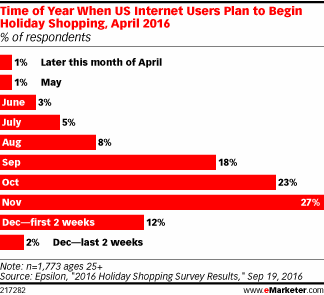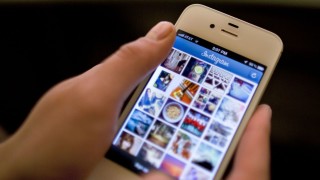Eating leftover Halloween candy for breakfast is a sober reminder that the holidays are coming up fast. Excited or not, how will US consumers handle the pressure and/or joy that is seasonal shopping? Grab another chocolate bar and let’s find out.
Holiday Shopping Happens Much Earlier Than You Think
If you haven’t started crossing items off your holiday shopping list yet, you’re not alone. In a September 2016 poll by Epsilon, 36 percent of respondents said they would start their holiday shopping before October, but Halloween seems to be the tipping point with 23 percent more starting around that time. Most of the remaining 41 percent of shoppers who plan to start after October will do so in November. In fact, November is the most popular month to begin the yuletide planning at 27 percent, with the least amount of consumers shopping for the holidays in the early months of April or May.

ECommerce Is Taking Over Retail
EMarketer predicts that holiday retail eCommerce sales will reach $94.71 billion and account for 10.7 percent of total retail sales for the first time. Kantar Retail has a similar outlook, forecasting online holiday sales to increase by nearly 16 percent for the fourth quarter of 2016 compared to 14.8 percent last year. Foot traffic to brick-and-mortar stores is in steep decline, especially as shopping malls become less popular. According to US Department of Commerce figures, department store sales have declined from $87.46 billion in 2005 to $60.65 billion in 2015. Consumers have, in recent years, made a shift to specialty stores over the everything-under-one-roof approach of the classic department store. RetailNext measured year-over-year drops in US retail foot traffic each month of 2016, peaking with a 9.9 percent drop in May. But those physical stores are still where the vast majority of shoppers will spend their holiday money.
Physical shopping is still (for now) the most popular method, however. According to a study by ad tech company, Fluent, 78 percent of respondents said at least half of their shopping will be done in stores, while 22 percent said at least half of their shopping will be done online.
Mobile Purchases Are Becoming More Common
The mobile phone changed the way we communicate, but the smartphone changed everything, including how consumers make purchases. Fluent’s study shows that a little more than half (54 percent) of consumers will research purchases online beforehand. In a recent report by Google, about 25 percent of US mobile video viewers utilized YouTube before purchasing while they were at a store or visiting a store’s website. Meanwhile, 45 percent of shopping trips include some mobile shopping, according to a Facebook IQ study of US internet users conducted in September 2015. Another Facebook study released in December 2015 revealed that during the holiday season, US millennials, moms and multicultural shoppers collectively drove 81 percent of all mobile transactions.
Social Is Influential
Is it important for brands to have a social media presence? Consumers say “yes,” according to an April study by G/O Digital. More than half of US social media users polled said a social presence has some degree of influence on whether they’ll buy from the brand during the holiday season. While 44 percent said that a brand’s social presence is “irrelevant” to purchasing decisions, 7.4 percent said that it was an important factor.
Now when someone else mentions a brand, that’s a different story. According to Hubspot, 71 percent of consumers are more likely to make a purchase based on a social media reference. In fact, when Levi’s added a Facebook “like” button to its website, the brand experienced 40 times the website traffic. Likewise, American Eagle customers spent 57 percent more after a “like” button was added. With the power of influencer marketing, it’s no wonder Facebook added eCommerce to its platform.
Ready? Set? Shop ’til you . . . oh, sugar crash.


